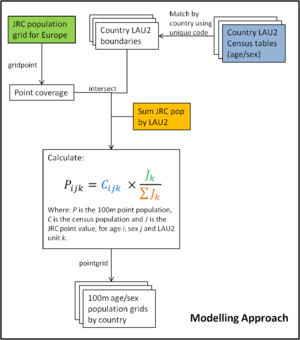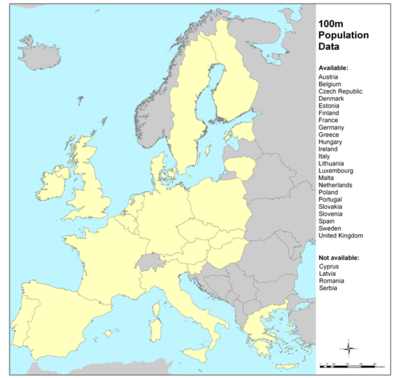EU age/sex stratified population: 100 metre grid
- The text on this page is taken from an equivalent page of the IEHIAS-project.


Even the highest resolution, LAU 2 level population data may be too coarse for some health risk assessments. Spatial modelling, therefore, may be required to disaggregate these totals to a finer grid. This has been done in several projects using land cover data as a basis for disaggregation (Briggs et al. 2007; Gallego 2010). Here the JRC population density grid (Gallego 2010) was enhanced by incorporating the age categories for both males and females from the census.
The modelling approach is illustrated below. Modelling involved proportioning the LAU2 level age/sex stratified data to the 100m cell on the basis of the JRC grid. Up to 28 grids (14 male and 14 female) were produced for each country depending on the structure of the age groups in the source tables.
Warning: These data are presented here at the 100m to offer flexibility in computing small area estimates at different spatial scales, however should not be taken to reflect population counts at the 100m level. Due to the lack of small area population data such as postcodes across Europe, these data were only validated for GB. Correlations (r) for total population were 0.92, 0.91 and 0.86 at the district, ward and 1km level, respectively. No correlation was found at the output area level. Similar modelling with validation found comparable results (Briggs et al. 2007), indicating that the 100m estimates could be reasonably aggregated to the 1km level.
Source / Reference
Three main sources of data were used to create these population grids:
- Small area census data
- Small area administrative boundaries (EuroBoundaryMap 1:1,000,000 January 2006 release)
- JRC population grid (version 4)
See also
Instructions:
Each country zip file contains up to 28 ascii files. To import into ArcGIS use the ASCII TO RASTER tool, or for ArcInfo use ASCIIGRID with the FLOAT option to create floating point grids.
Data are based on ETRS89 Lambert Azimuthal Equal Area projection with parameters: latitude of origin 52° N, longitude of origin 10° E, false northing 3 210 000.0 m, false easting 4 321 000.0 m.
 be Belgium
be Belgium dk_0 Denmark
dk_0 Denmark ee_0 Estonia
ee_0 Estonia ie_0 Ireland
ie_0 Ireland lt_0 Lithuania
lt_0 Lithuania lu_0 Luxembourg
lu_0 Luxembourg mt_0 Malta
mt_0 Malta ni_0
ni_0 nl_0 the Netherlands
nl_0 the Netherlands pt_0 Portugal
pt_0 Portugal si_0 Slovenia
si_0 Slovenia sk Slovakia
sk Slovakia
- File:ATstratifiedpopulation.zip
- BE age/sex stratified population: 100 metre grid
- CZ age/sex stratified population: 100 metre grid
- DE age/sex stratified population: 100 metre grid
- DK age/sex stratified population: 100 metre grid
- EE age/sex stratified population: 100 metre grid
- ES age/sex stratified population: 100 metre grid
- FI age/sex stratified population: 100 metre grid
- FR age/sex stratified population: 100 metre grid
- GB age/sex stratified population: 100 metre grid
- GR age/sex stratified population: 100 metre grid
- HU age/sex stratified population: 100 metre grid
- IE age/sex stratified population: 100 metre grid
- IT age/sex stratified population: 100 metre grid
- LT age/sex stratified population: 100 metre grid
- LU age/sex stratified population: 100 metre grid
- MT age/sex stratified population: 100 metre grid
- NI age/sex stratified population: 100 metre grid
- NL age/sex stratified population: 100 metre grid
- PL age/sex stratified population: 100 metre grid
- PT age/sex stratified population: 100 metre grid
- SE age/sex stratified population: 100 metre grid
- SI age/sex stratified population: 100 metre grid
- SK age/sex stratified population: 100 metre grid
- Dasymetric modelling of small-area population distribution using land cover and light emissions data. Remote Sensing of Environment. Briggs D.J., Gulliver J., Fecht D. and Vienneau D.M. 2007. 108(4):451-466.
- A population density grid of the European Union, Population and Environment. Gallego F.J. 2010. 31: 460-473.